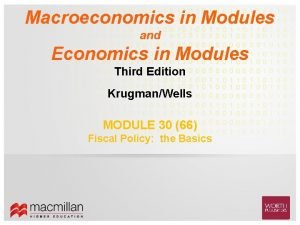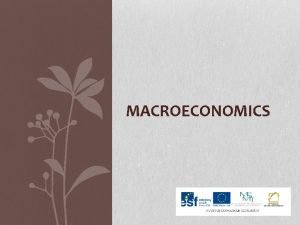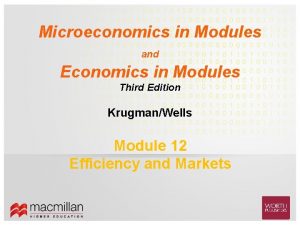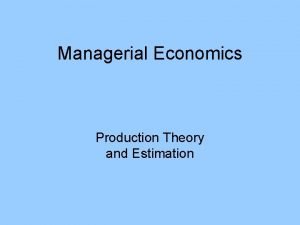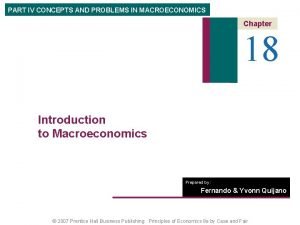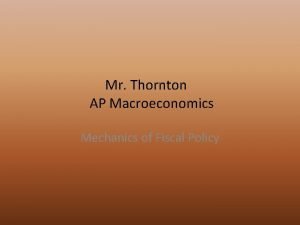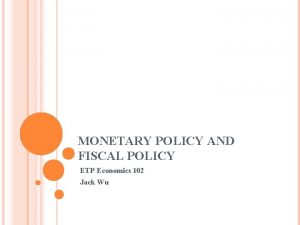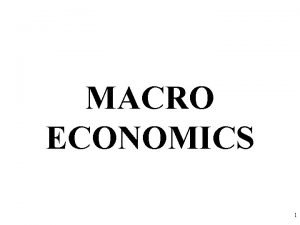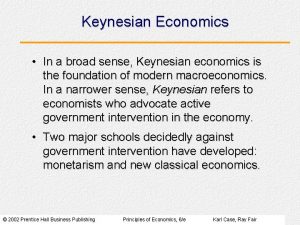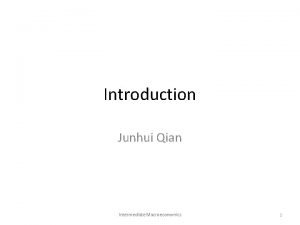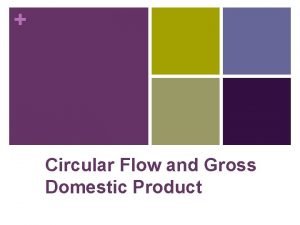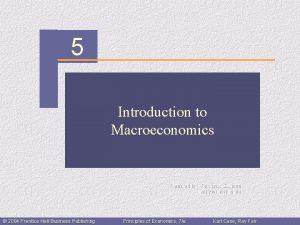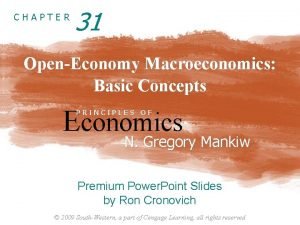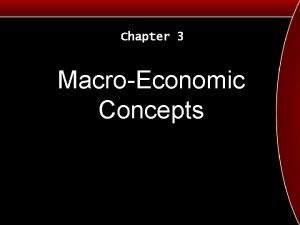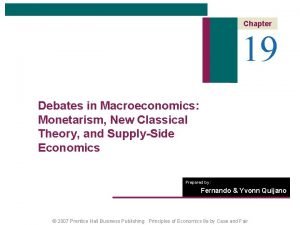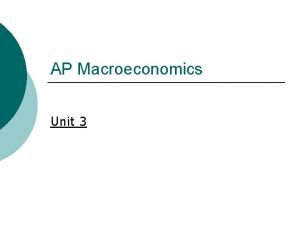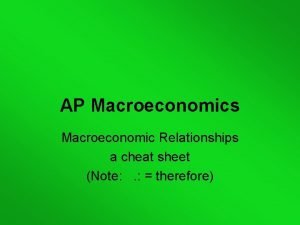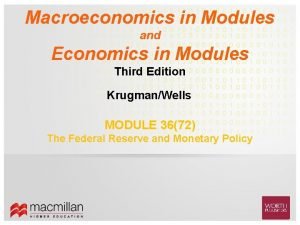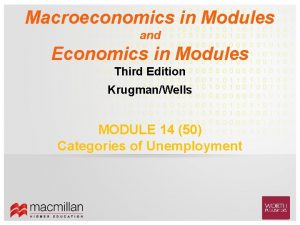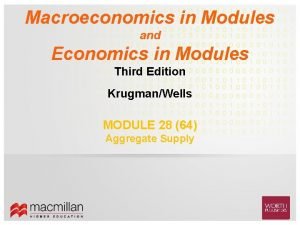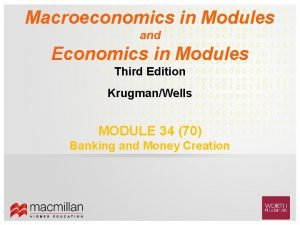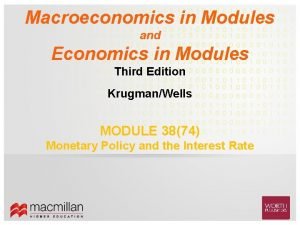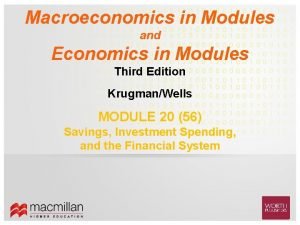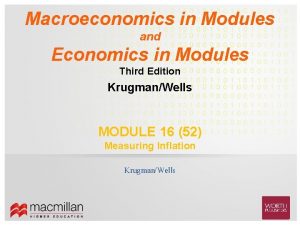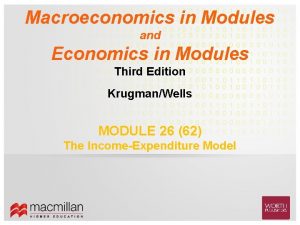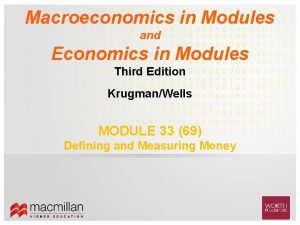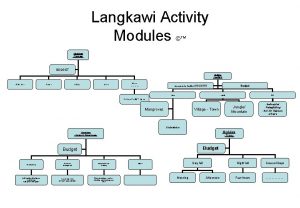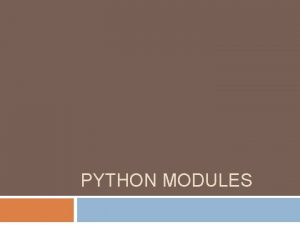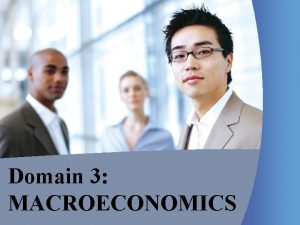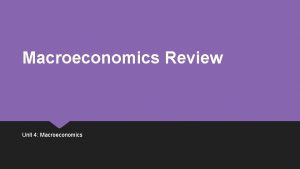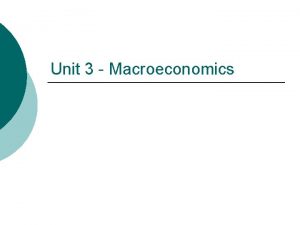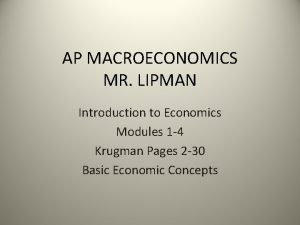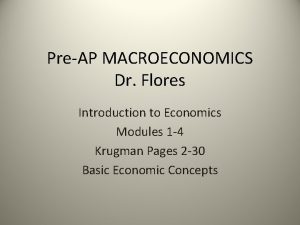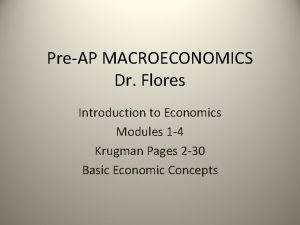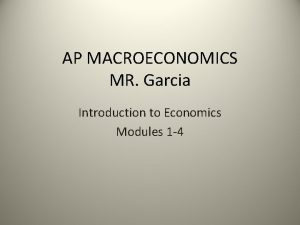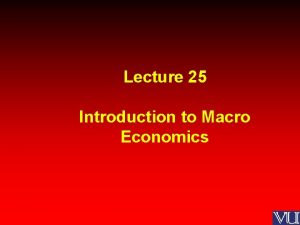Modules 1 3 Introduction to Economics Macroeconomics Production



























- Slides: 27

Modules 1 -3 Introduction to Economics & Macroeconomics Production Possibilities Curve

Key Assumptions in Economics • People are rationally self-interested • They seek to maximize their utility • People generally make decisions “at the margin” • They weigh the marginal benefit against the marginal cost of a decision • Ex) Should I buy 1 taco or 2? 5 donuts or 6? 10 gallons of gas or 11? • Ceteris Paribus • Economists hold factors constant, except for what’s being considered

Ceteris Paribus

Ceteris Paribus

Basic Vocabulary • Economics: the study of choices people make to satisfy their needs & wants • Microeconomics: the study of how individuals & firms deal with scarcity • Macroeconomics: the study of how a society deals with scarcity • Needs: necessities for survival • Wants: goods & services consumed beyond what is necessary for survival

Basic Vocabulary • Goods: physical objects that can be purchased • Services: actions or activities performed for a fee • Consumers: people who purchase goods & services • Producers: people who supply goods & services

Resources (Factors of Production) Resource: anything that can be used to produce something else; classified resources into 4 categories Resource Type Definition Payment Land Natural resources Rent Labor Human resources Wages Capital (a product of Investment) Tools, machines, factories… all manufactured goods used to make other goods/services Interest Entrepreneurship The special ability of risk-takers to combine land, labor & capital in new ways to make profit Profit

Types of Economies • 2 types of economies • Market: there is no central authority making production & consumption decisions; they are made by firms & individuals • Ex) US • Command: there is a central (government) authority making production & consumption decisions; industry is publicly (government) owned • ex) USSR

Types of Economic Analysis • 2 types of economic analysis • Positive: describes the way the economy actually works; has right & wrong answers • Normative: makes prescriptions (recommendations) about the way the economy should work • Ex) NTTA is considering ↑ the toll on PGBT by $0. 50 • How much revenue would tolls bring next year without an ↑? • How much revenue would tolls bring next year with an ↑? • Should the toll be raised, knowing that it would likely reduce traffic but bring financial hardship to some drivers?

video • https: //www. youtube. com/watch? v=Yt. X 6 SGw 7 E 3 c https: //www. youtube. com/watch? v=ODYE_Ka. Lj. A 0

Fundamental Problem of Economics: Scarcity • People have unlimited wants, but the resources to satisfy those wants are scarce • Thus, we must make choices about how to use our scarce resources • We face trade-offs when it comes to using available resources

Fundamental Problem of Economics: Scarcity Ex) Assume flour is a scarce resource; 3 cups of flour can be used to make a loaf of bread or a cake, but 3 cups cannot be used to make both OR

Opportunity Cost • Once a resource (a factor of production) has been used, an opportunity cost is incurred • Opportunity cost: the next best alternative use for a resource • Ex) If the 3 cups of flour are used to bake bread, the opportunity cost is the cake that could have been baked with the 3 cups of flour • No matter what we do with our time or resources, we always incur opportunity cost…TINSTAAFL!

TINSTAAFL! There is no such thing as a free lunch! Everything has a cost/trade-off/opportunity cost!

video https: //www. youtube. com/watch? v=lp. Sz 2 x 0 c 1 r. U

Trade-Offs Illustrated: PPC Production Possibilities Curve/Frontier: Shows all of the possible combinations of output & the trade-offs in an economy fully using all of its resources & only producing 2 goods

all points along the line are “productively efficient” unless the society imports resources

Increasing Opportunity Costs = Increasing Slope PPC’s slope = opportunity cost for the X-axis good in terms of the Y-axis good As more fish are produced, its opportunity cost rises

Types of Efficiency • Productive: when an economy is at ANY point along the PPC • Allocative: when an economy is at THE SPECIFIC point along the PPC that best fits the demands of its consumers

Business Cycle • The US’ GDP is not constant from year to year; it grows in most years & shrinks in some • The upturns & downturns in GDP over time = the business cycle

Business Cycle • Peak • Temporary max in output (real GDP) & employment • Unemployment low & inflation high • Recession • Output (real GDP) & employment falling • By definition, must last for at least 6 months • Depression: deep, prolonged economic downturn • Trough • Bottom of cycle • Unemployment high & inflation low • Recovery/Expansion • Output (real GDP) & employment rising

Business Cycle • Causes • Irregularity of investment • Changes in productivity & spending • Durable goods industries have been most susceptible to the cycle’s effects • Has become less severe over time (macroeconomics)

Business Cycle • Labor force: employment + unemployment • Employment: total # of people currently working for pay • Unemployment: total # of people actively looking for work but not currently employed • Unemployment rate: % of the labor force that is unemployed • Output: quantity of goods & services produced • Aggregate output: an economy’s total production of goods & services for a given time period, usually a year

Business Cycle • During a recession, unemployment ____ & output ____ • During a recovery/expansion, unemployment ____ & output ____ • Within the business cycle, unemployment & output move in ____ directions

Business Cycle • Price level (PL): assesses prices of goods & services across a society • Inflation: rise in overall PL • Deflation: fall in overall PL • Price stability: overall PL is changing very slowly or not at all; helps keep the economy stable • Economic growth: increase in the max possible output (real GDP) of a society; leads to higher wages & standard of living

Economic Growth 2 sources of economic growth: 1) Increase in LLC or E 2) Technological progress

Gross national product (GNP) • The dollar value of all final goods, services, and structures produced within a country’s borders 12 -month period.
 Macroeconomics in modules
Macroeconomics in modules Pengertian produksi multimedia
Pengertian produksi multimedia Branch of economics
Branch of economics Economics modules
Economics modules School of business and economics maastricht
School of business and economics maastricht Econ213
Econ213 Empirical production function managerial economics
Empirical production function managerial economics Economics subject
Economics subject Macroeconomics
Macroeconomics Crowding out effect macroeconomics
Crowding out effect macroeconomics Crowding out effect macroeconomics
Crowding out effect macroeconomics Contractionary monetary policies
Contractionary monetary policies Meaning of managerial economic
Meaning of managerial economic Structural rate of unemployment
Structural rate of unemployment Micro macro
Micro macro Nominal gdp
Nominal gdp New classical macroeconomics
New classical macroeconomics New classical macroeconomics
New classical macroeconomics Crowding out effect of fiscal policy
Crowding out effect of fiscal policy 2012 macroeconomics frq
2012 macroeconomics frq Calculate gdp circular flow diagram
Calculate gdp circular flow diagram Ap macroeconomics-percentage for a 5
Ap macroeconomics-percentage for a 5 Chapter 31 open economy macroeconomics
Chapter 31 open economy macroeconomics Macroeconomics deals with?
Macroeconomics deals with? Supply side economics
Supply side economics New classical macroeconomics
New classical macroeconomics Ap macroeconomics unit 3
Ap macroeconomics unit 3 Ap macroeconomics cheat sheet
Ap macroeconomics cheat sheet
